#gresley a3
Explore tagged Tumblr posts
Text

#at last I can sleep#don't zoom in too far#there are some wobbly lines because it was drawn on a steam-hauled train lmao#flying scotsman#flying scotsman centenery#gresley a3#preserved british steam locos#british steam#copic markers#actually cheap knockoff copics but who's keeping track#my art owo#going to have nightmares about valve gears for months#flying scotsman ttte#wagahai wa train de aru
218 notes
·
View notes
Text

Scoobnation: 12 different Scotsman
A little project that kinda escalates but it was great fun drawing all those silly Manz.
From top left to bottom right: @lorainedoesthings , @00lemonfizz00 , @man-made-dragons , @/_ghostly.doodles_(Instagram), @cinnabowlii , @klein-sodor-bahn , @pixie-dvsst , @konnosaurus , @panicky-pansexual , @ballercoles , @zalabratart and @just-another-miserable-prick
#ttte#ttte human au#ttte humanized#thomas and friends#ttte flying scotsman#flying scotsman#fanart#human au#thomas and friends humanized#ttte scotsman#lner a3#lner#gresley family#konnosaurus#00lemonfizz00#cinnabowlii#sparrowspearowhawk#ballercoles#panicky-pansexual#pixie-dvusst#lorainedoesthings#_ghostly.doodles_#zalabratarts#just-another-miserable-prick#Big thanks to everyone who offered their Scoobs.#And a big I hope you like him to the two surprised additions
98 notes
·
View notes
Note
Did you know one of the great A1/A3 pacifics was named Gay Crusader?
Yep. A fine Race Horse name honestly. Gets your attention immediately!
My personal favorite are Sandwich, Sir Visto, Galopin and Flamingo. Hilarious names for such awe-inspiring heaping machines of metal, fire and speed!
I mean, come on... How do you compete with Great Northern, Sir Frederick Banburry, Flying Scotsman, Solario, Enterprise, Robert the Devil, Prince Palatine or even Isinglass when you're named Sandwich???
#Steam Engines#Steam Locomotives#Gresley A1 Pacifics#Gresley A3 Pacifics#Anon as a member of the TTTE Fandom who's vastly fascinated by Gordon I can assure you I know the A1/A3 naming scheme (barring Scotsman)#But I find infinite amusement in remembering someone in Doncaster had to go through a list of race horse names#to christen their locomotives#and someone straight up greenlit 'sandwich' as a worthy loco name#must have been one impressive race horse!
6 notes
·
View notes
Photo

Presenting the LNER A1/A3 Pacific!
#LNER#London North Eastern Railway#LNER A1#LNER A3#A1 Pacific#A3 Pacific#4-6-2#Gresley Pacific#Hazel's files#flying scotsman#pretty polly
19 notes
·
View notes
Text
This part really interests me...
"A little known fact is that in the late 1990s, when the steam engine "Flying Scotsman" (LNER 4472) was in masonic ownership, there was a serious plan to revive the Warrant of United Gauges Lodge No 4472, in order to authorise a travelling lodge to meet in connection with special steam services operated by the locomotive of the same number. Sadly this ambitious plan was never completed."
Every trade should have their own esoteric/masonic tradition. I want to know what irrigation engineering says about the nature of god.
#Freemasonry#real railways#real true railway stuff#LNER A1/A3 Gresley Pacific 4472 “Flying Scotsman”#Masonic lodges
1K notes
·
View notes
Text
a thought occurred to me (that i shall now tell to you, my friend Callisto, who i am currently writing to in my discord DMs) If Henry's a 4-6-0, i think it makes a lot more thermodynamic sense than if he's a 4-6-2.

imagine if you wanted to make a more powerful Atlantic. (without sacrificing speed) ultimately you're going to need either more cylinders, or larger cylinders or both. but more tractive effort means less factor of adhesion. no use getting more tractive effort if you're slipping. So you add the extra drive wheel in place of the trailing wheel. this design now has three, larger cylinders. More tractive effort, and a relatively similar footprint. You will need a conjugated valve gear or at the very least three sets of walschearts valve gears, rather than internal stephenson valve gear. But the frames and boiler can be nearly unmodified. unfortunately after some analysis you, Sir Nigel Gresley, realize it's never going to work. There's just not enough fire grate area and you use steam faster than you can build it. You're going to need to start from scratch with a new boiler. That second plan is the first version of the A0 prototype, Gordon, which as we know is thought to have been refined into more or less mechanically identical to the production A1 class. but the first plans, discarded, were built as Henry. Henry should have same tractive effort and top speed, or nearly so, as Gordon, but without the boiler volume or fire grate area to match.
in theory running him as if he had indeed been an Atlantic--just as fast but with a shorter, lighter train--should have worked. But that's when we get into the other mechanical issues that resulted from being a… "bastard." I wouldn't be surprised if, at least before repairs were undertaken, Henry's boiler had to be de-rated to a lower pressure to avoid leaks (or worse). Lower pressure means not just less power, but less efficiency too. the Ivatt Atlantics and the Gresley A1 Pacifics had similar boiler pressures of 170 and 180 PSI respectively. (the A3s were uprated to 220 PSI; but Gordon probably never was since i believe his post rebuild boiler is his original boiler.)
Cylinders Two, outside (Majority), Four (2 outside + 2 inside) on No. 3292 Compound & 3279
WHAT
a C1 Atlantic was fitted with four cylinders????
No. 292, built at Doncaster in 1904 (but not entering service until 1905), was a four-cylinder compound. The high-pressure cylinders, having a diameter of 13 in (330 mm) and a stroke of 20 in (510 mm), were outside the frames, driving the rear coupled wheels; and the low-pressure cylinders, 16 by 26 in (410 by 660 mm) were inside, driving the front coupled axle. The valves were arranged so that the locomotive could work either as a compound or as a four-cylinder simple. The boiler pressure was 200 lbf/in2 (1,400 kPa), but whilst the boiler was under repair, the locomotive used a 175 lbf/in2 (1,210 kPa) boiler from 1910 to 1912. This locomotive was withdrawn in 1927 and scrapped in 1928.[9]
No. 1300, another four-cylinder compound, was an experimental locomotive which differed greatly from all of the others. It was built by Vulcan Foundry in 1905, largely to their own design although to Ivatt's specifications. The boiler had a narrow firebox, a diameter of 5 ft 3 in (1.60 m) and a pressure of 200 lbf/in2 (1,400 kPa). As with No. 292, the high-pressure cylinders were outside, driving the rear coupled wheels, whilst the low-pressure cylinders were inside, driving the front coupled axle; but their dimensions were 14 by 26 in (360 by 660 mm) and 23 by 26 in (580 by 660 mm) respectively. The engine worked as a two-cylinder simple on starting, changing over to compound expansion automatically. A superheater was fitted in 1914, and the engine was rebuilt as a two-cylinder simple in 1917; the new cylinders were outside, 20 by 26 in (510 by 660 mm) of the type used on class H3, driving the leading coupled wheels. It was withdrawn in 1924.[10] the cylinder diameters varied wildly on the C1s too
a compound loco would have superior efficiency. a simple loco with four cylinders on the other hand would chew through steam twice as fast. idk… idk… a 4-6-0 Henry with an atlantic boiler might not be possible

i mean the whole point of an atlantic is it's a 4-4-0 with a bigger firebox there were small boiler atlantics like this that could accomodate a third driver

but the outline of this engine is definitely more like James than Henry god and like. even this engine, with a much smaller firebox and boiler than the large boiler C1s, still has the same cylinder dimensions as them and only slightly smaller than the pacifics. giving Henry a big wide firebox matches the illustrations, it matches the tvs model, but… it's also explicitly the problem with Henry. so like. it's difficult to really figure out a realistic answer to what's wrong with Henry's design that would be fixed by better coal.

37 notes
·
View notes
Note
Another day of breaking Winter's mind with trains because it's my area of expertise. Today, I have 2 special locomotives from the UK, each incredible in their own right. First, the Flying Scottsman.

What makes this A3 Special? It was the first locomotive to ever hit 100 miles per hour.
"WhAt AbOuT cItY oF tUrO-"
SHUT! That was never confirmed! And I highly doubt it because City of Turo is a 4-4-0! Name one 4-4-0 that can keep up with the Pacific wheel arangment. And don't mention that one American 4-4-0 I know nothing about people claim hit 100.
Anyhoo, that's not all Flying Scottsman is known for. Yeah it was special for marking a important milestone in steam engine technology, but it's also been paraded around the globe. First in a tour across America, which was cut short when it's private owner went bankrupt, and it was in danger of being scrapped to pay off debts. However, it was saved by another steam enthusiast who brought it back to Britan, and later it went on a much more successful tour through Australia.
Flying Scottsman has also gone through other important changes. For instance, see those smoke deflectors on the smoke box? Those weren't always there. At some point as well, Flying Scottsman had two tenders for fuel, with a special system to pick up extra water on the go. And of course when it went to America, it needed a bell to alert people, a cowcatcher just incase animals strayed on the tracks, and even a US railroad regulated head light.
Flying Scottman is legendary, no doubt. But it's not the fastest locomotive ever though. That honor belongs to, this legend of steam.

Mallard is an A4 Pacific, and the world record holder for steam speed at 126 miles per hour. Designed by Sir Nigel Gresley, same as Flying Scottsman, the A4 is a sleek and elegant cousin to the A3's.
These two locomotives are some of the most influential and praised, and each have their very own place in history.
”Wow.. I keep getting more and more amazed every time I get told stories like these!” -Winter
[plain text: Wow.. I keep getting more and more amazed every time I get told stories like these!]
8 notes
·
View notes
Text
Happy 4/4 Gordon Day to those who celebrate
I have a Gordon drawing on the way, it will take a little bit but for now... enjoy this perennially old meme I find funny...
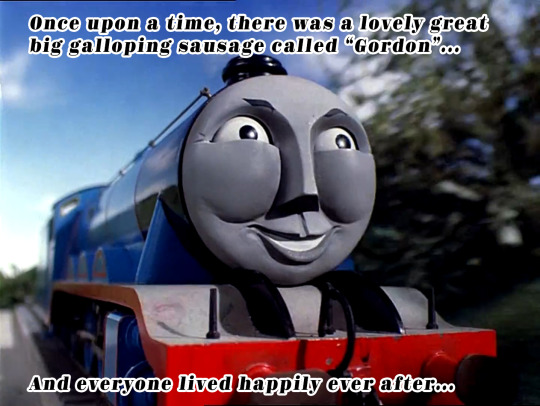
Here's to Gordon Nigel Gresley, North Western Railway ex-LNER A0 Pacific No. 4; the first of the proud line of the Gresley A1s/A3s, the Shooting Star; around whom the Railway Series begins and ends.
#ttte#rws#happy gordon day#gordon the express engine#gordon the big engine#ttte gordon#4/4#thomas and friends
29 notes
·
View notes
Text
Did SP 4449 and LNER 4472 ever meet??????????
Or were they fated to ever pass like two ships in the night???
Treading the same steel rails and seeing the same trackside sights, yet never meeting nor catching a glimpse of the other's headlight ...
So much in common, yet so different -- could a sophisticated coal-smoking 4-6-2 and an oil-sipping streamlined 4-8-4 find compatibility? How would it feel to touch coupler knuckle to buffer stop? Would they find out the joy of double heading together or of pushing a caboose uphill?
4449 wistfully daydreams about a taking a steamship holiday to the UK -- could they meet up? Would it be awkward? Would there be adventures? How would it feel?
4472 rests and reflects on everything a prestigious and pedigreed long-distance express passenger locomotive should reflect on, having accomplished so much with so much honor and award -- a centennial A3 out and about making Sir Nigel proud and true to the Doncaster Works roots -- yet not an engine to pine wantonly, one thing, nay: one locomotive often filled Flying Scottsman with tingles of desire from smokebox to firebox as full as a tender of fresh coal, sighing with a whisper of steam: 4. 4. 49.
They do have something in common, the Flathead Tunnel in remote Northwest Montana
https://youtu.be/-AUqRU_PAtE?si=J25sOXyrGf1NTGtp



Flying Scotsman and some Americans
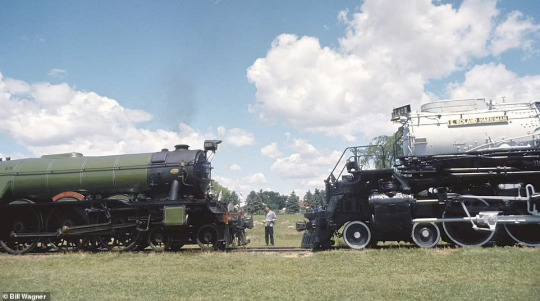



halp plz :(

#fan writing#4449#4472#A3 4472#LNER#(it will be confusing with the Gresley A3 being part of the GS numbering series -- sorry 4472)#4472 if masculine would have to be exactly like Craig Ferguson#60103#(British Rail)#flying scotsman
240 notes
·
View notes
Text
Happy Mallard Day!
Most people in my country will be celebrating tomorrow, July 4th. I’m a bit unusual for an American in that I’m always more excited for July 3rd, because a remarkable feat of engineering history happened that day in 1938 (in multiple senses of the word). Today I’m going to tell the story of a locomotive named for a duck.
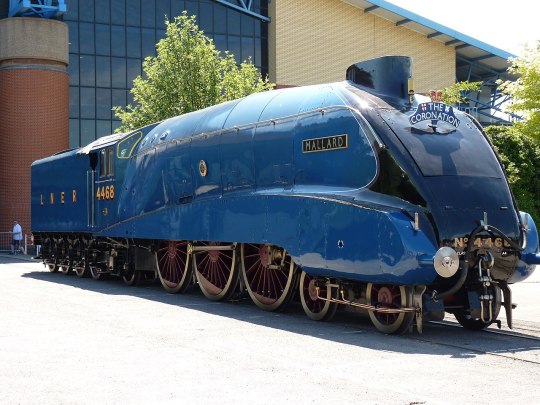
(Image: 4468 Mallard, a streamlined 4-6-2 Pacific locomotive, sitting pretty in York, England, United Kingdom. She is painted bright blue with red wheel spokes.)
The story begins well before July 3rd, 1938, of course - mechanical engineer Sir Nigel Gresley was well established in his position as the CME of the London and North Eastern Railway by that date. In 1923, his most famous creation, a 4-6-2 Pacific A1 numbered 4472, took to the rails for the first time. Originally numbered 1472, within a year of running between London to Edinburgh she received her more familiar 4472 after the LNER finally settled on a company-wide numbering scheme - and the name she’d be best known under, Flying Scotsman. She became the company’s flagship locomotive and solidified Gresley’s ability to design Pacifics in the mind of the public.
Her most important contribution to what I’m about to get into the meat of here, though, occurred on November 30th, 1934. On that date, pulling a light testing train behind her, Flying Scotsman hit 100 mph, becoming the first locomotive to hit that speed whilst being officially measured. Other locomotives may have reached 100 mph before, most notably GWR 3700 City of Truro and NYC 999, but this was the first time the speed was officially recorded, and so Scotsman got her name into the record books.
Dating back to the 19th century, railroads in Great Britain competed against each other in what was known as the Race to the North, in which they actively attempted to outdo each other and get passengers from the south, usually London, up to various destinations in Scotland. Nobody ever actually said they were racing, of course, but in retrospect it was pretty obvious what was going on as the railroads introduced faster and faster services. By the 1930s, the railroads had been consolidated into four companies - the Big Four (the Great Western, the Southern, the London, Midland and Scottish, and the heroes of this story, the London and North Eastern). The LMS controlled the West Coast Main Line, and the LNER controlled the East Coast Main Line. (This is important.) In 1927, the LNER started running the named train Flying Scotsman non-stop from London to Edinburgh, utilizing corridor tenders to perform crew changes at speed without stopping. Not to be outdone, the LMS beat them to the punch, running non-stop services between London and Glasgow and London and Edinburgh on their own, and it was officially on. Although speeds were still within a reasonable range at this point, both railroads knew they needed to go faster, and Sir Nigel Gresley looked to Germany.
In Germany, a new streamlined service called the Flying Hamburger had been introduced. This was a diesel train set that ran between Hamburg and Berlin at remarkably high speeds - it had an average speed of 77 mph and could hit around 99-100 mph at its maximum. For regular service, this was impressive, and Gresley wondered if the same could be done using steam power. He knew streamlining was the key, but the LNER knew that the diesels in Germany didn’t have the same passenger capacity as their steam locomotives could pull in carriages, so he needed to get creative. He looked to Bugatti for inspiration; their racecars, in their resplendent blue, were but one thing the car company was working on - they were making streamlined railcars, as well. Gresley took note of their designs, and his new locomotives would eventually pay homage by being colored Bugatti blue.

(Image: a Bugatti Type 54 racecar, painted in a vivid blue.)
By the time Flying Scotsman hit 100 mph in 1934 and another Gresley Pacific locomotive, A3 2750 Papyrus, managed to hit a whopping 108 mph without streamlining, the LNER knew that Gresley was capable of the task, and they allowed him to design a streamlined locomotive. Gresley set to work making improvements to his A3 design, and the first four A4s were born.
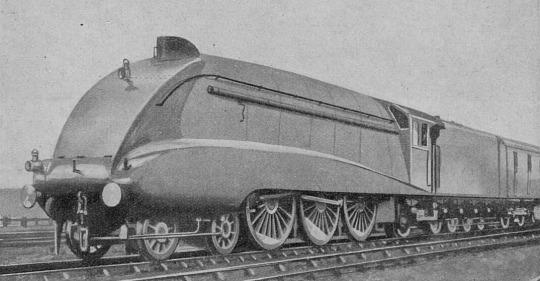
(Image: an unidentified A4 Pacific locomotive.)
The A4s were fast, hitting 112 mph on the inaugural run of the Silver Jubilee service between London and Newcastle in 1935. Gresley, of course, was not satisfied - he knew he could still improve his design, and at any rate, his competition over at the LMS was going to be trying to catch him. He went back to the drawing board to make the A4s even better.
As this was going on, the LMS was indeed playing catchup, and they introduced their beautiful Coronation class locomotives, designed to pull the Coronation Scot starting in 1937. The first several of them were streamlined in gorgeous, bright casings, and they caused a stir, taking the British speed record back at 114 mph in an attempt by 6220 Coronation that ended with a sudden braking and a whole lot of kitchenware being flung every which way in the dining car. Engineer/driver T.J. Clark and fireman C. Lewis kept her under control, but the passengers were not amused, and speed records were shelved for the time being...until, once again, Germany entered the fray.
Back in 1936, a German locomotive, the DRG Class 05, set a land speed record for steam, hitting 124.5 mph. Gresley was aware of this and had it in the back of his mind as he improved his A4s. He experimented with giving some of them a Kylchap exhaust system, an innovation developed by French locomotive designer André Chapelon after the work of Finnish engineer Kyösti Kylälä. Chapelon’s work went woefully under-acknowledged, but Gresley paid attention and appreciated his work, and it would pay off. Wind tunnel tests proved a bit frustrating at first until a fortuitous accidental thumbprint helped to move the smoke up and over the locomotive instead of in the crew’s faces, and the stage was set.
4468 Mallard rolled off the line at Doncaster Works on March 3rd, 1938, her name derived from Gresley’s love of breeding waterfowl. Indeed, many of her sibling locomotives were also named for birds, like 4464 Bittern, 4467 Wild Swan, 4902 Seagull, and 4903 Peregrine, but the duck was about to steal the show. Mallard spent the next few months getting used to working and being broken in so she wasn’t brand new, and on the day she turned four months old, it was time to make history.
Mallard’s driver that day was a 61-year-old grandfather named Joe Duddington. As a locomotive engineer, he was experienced and knew how to take calculated risks, and so he’d been assigned to pilot her. With him on the footplate was fireman Tommy Bray and his massive tattooed arms, ready to keep Mallard fed as they drove into the history books. They were performing a “brake test” that day, or so the LNER told most people, passengers included, but Joe and Tommy knew what was actually going on. In the cab with them was an LNER official, Inspector Jenkins, and attached to the train behind the tender was a dynamometer car, there to record Mallard’s speed throughout her run. Since this was an alleged “brake test” the dynamometer car didn’t raise any eyebrows right away. Gresley himself unfortunately wasn’t in the best health that day and was unable to be present himself, but there were enough LNER officials on hand to see to it that everything ran smoothly. Mallard was fitted with a stink bomb of sorts of aniseed in case the big end bearing for the middle of her three cylinders overheated, as the A4s had previously had difficulty with this, and she set out heading northwards. The return trip was where everything was going to get serious.
Upon turning around to return south to King’s Cross, passengers were finally informed of what was going to happen and were given the opportunity to disembark and take another train if they were worried, especially given what had happened during the LMS record attempt a year prior. Everyone agreed to stay on board. Joe Duddington turned his hat backwards, a reference to George Formby’s character in the film No Limit, and opened the throttle.
Mallard slid back onto the main line, headed towards Grantham, where the speed-up was to begin. Unfortunately, work on the track limited her to only 15 mph at this stage, and Joe Duddington got her through the Grantham station at only 24 mph instead of the 60-70 mph she should have been at. Nevertheless, she began to build up more and more speed as she climbed up Stoke Bank, and Duddington had her at a solid 85 mph at the summit.
“Once over the top, I gave Mallard her head, and she just jumped to it like a live thing,” Duddington recounted later in an interview. Her speed rapidly increased, and she was soon hitting 110 mph, at which point he told her, “Go on, old girl, we can do better than this!” Mallard responded, and by the time she was flying through a village called Little Bytham, a blur of blue paint and pumping rods and flying ash, she had well exceeded the LMS record and was even with the German DRG Class 05. The needle in the dynamometer car tipped up higher and higher and surpassed the Class 05 by slipping up to 125 mph...then, for about a quarter of a mile, reached even higher, at 126 mph. She’d done it.
Mallard had to slow down soon after because of a junction, but Joe Duddington and Tommy Bray were sure she could have gone faster had they not had to slow for construction - they believed she was capable of 130. The big end bearing did overheat, and Mallard was detached from the train at Peterborough and brought back to Doncaster to be fixed up, but not before one of the most famous photos in railroad history was taken:

(Image: the crew poses in front of Mallard, a 4-6-2 Pacific locomotive numbered 4468, immediately after setting the speed record. L-R: Tommy Bray [fireman], Joe Duddington [driver/engineer], Inspector Jenkins, Henry Croucher [guard/conductor]. Joe Duddington has turned his hat around to face the correct way again after having it on backwards during the record run. Photo credit: National Railway Museum.)
Joe Duddington actually stayed on a bit past his retirement age to help free up soldiers for the war effort. When he finally retired, on his final day of work, he drove Mallard one last time.
Sir Nigel Gresley himself never accepted the brief stint at 126 mph, instead saying his locomotive set the speed record at 125 mph. But history has accepted the 126 mph as the true top speed, given that Mallard was possibly capable of even more, and today she has plaques on her streamlined cladding to commemorate her feat. A second record attempt was planned to see if she could go even faster, but World War II broke out and the idea was scrapped.
youtube
Tommy Bray eventually got on the throttle himself, fulfilling his own dreams. Both men are honored in a cemetery in Doncaster with a new memorial headstone for Duddington featuring Mallard on it.
As for Mallard herself, she continued working until April 25th, 1963, at which point she’d clocked nearly a million and a half miles in service. She was pulled for preservation for obvious reasons, and today she lives at the National Railway Museum in York, along with her dynamometer car that recorded her history-setting run. Five of her A4 siblings also survive, and a few of them are operational to this day, including the one named for her designer, Sir Nigel Gresley. Of all of his ‘birds,’ the one that flew fastest was the humble duck.
For more on Mallard and her creator Gresley, here are a few resources:
Mallard: How the Blue Streak Broke the World Speed Record by Don Hale is a great book on the subject that I enjoyed thoroughly. It does have a Kindle edition if you’d prefer an ebook variation, as well, and most major book retailers carry it on their websites.
The National Railway Museum, Mallard’s retirement home, has a 3D experience/ride of sorts that simulates what it was like to be running with her that day, the video of which is online here. Note the music, which mirrors her three cylinders pumping away. The video isn’t able to be embedded, but you can watch it here. There’s also a child-friendly version, too.
Lastly, the appropriately named prog rock band Big Big Train did a song about Mallard called East Coast Racer, which regularly moves me to tears because this locomotive means so much to me and they tell her story so lovingly.
youtube
I actually recommend checking out the live version, too, because they show the photo of the crew at the end and every single time I start sobbing.
If you want to visit the old girl herself, she’s at the National Railway Museum in York in the UK, and they have a ton of amazing resources and incredible locomotives and rolling stock in their collection. I’d highly recommend checking them out if you can!
Happy Mallard Day, everyone. Fly far, fly fast, make history.
#LNER Mallard#LNER 4468 Mallard#LNER#LNER A4#I like trains#I spent literal hours on this whoops#but she's really important to me
113 notes
·
View notes
Video
Iconic Ex-LNER Gresley A3 Pacific no. 4472 "Flying Scotsman" passes the turntable at Marylebone as it departs with a Shakespeare Limited Sunday luncheon train on 28th September 1986 por Ian Duffield Por Flickr: 4472 - Marylebone 28-09-1986 R844bw Olympus OM40 (film) Fujichrome colour slide scanned to digital
14 notes
·
View notes
Text
Have some 2x5, 4x22, and MollyxDuck!
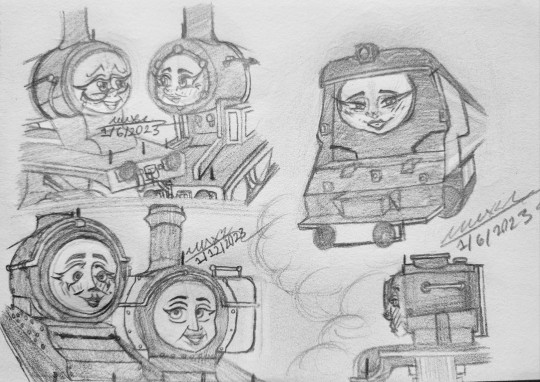
Tried out something I've been wanting to do with the eyes for a while but I kept forgetting :p the final push was a really cool artist on IG, @/mino_4rtx. you should totally check them out btw, especially if ya like Sonic 👀 Eating up his art ajsdfhaslkj It's gorgeous
Closeups/separate sketches, along with the references, are below the cut /nwn/
SEPARATE SKETCHES
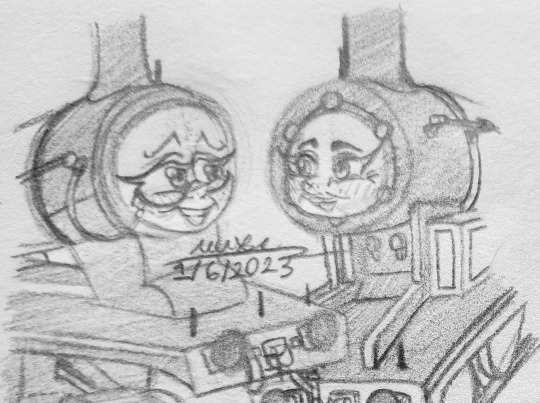

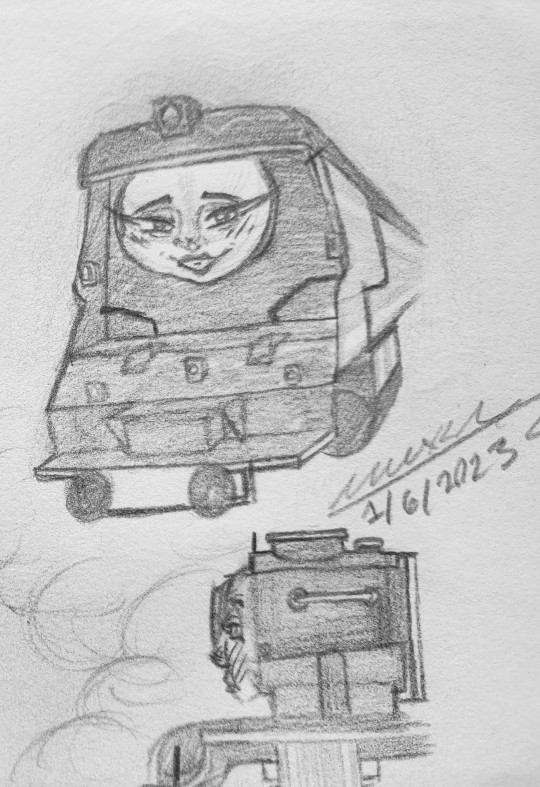
REFERENCES
4x22 sketch is based on this:

I used refs for the MollyxDuck sketch because I've been having trouble drawing those two in general, so here are the ones I used! (each image as a link embedded)

Thomas' Color Book (what's linked is the full image. the cropped image can be found in Molly's gallery)
used for Molly's eyebrows

Molly's Special Special (Promos) - Season 9 Episode 3
For posing and Molly's face. I also used it to reference Duck's height with the next one (left)

Best Friends - Season 12 Episode 20
Used for posing and height reference

Excellent Emily - Season 12 Episode 8
Used as a guide for his face (while also using a couple sketches I did as references too)
Because I'm trying to stick to their IRL basis as close as possible, I did some referencing on Rebecca, Gordon, Molly, and Duck (Edward and James are pretty much custom engines [somewhat])
For Duck, I referenced GWR 4612. I used the header image of this engine's "biography".
For Gordon, I referenced the Flying Scotsman. References came from that same place, as well as the blueprints on the GNR Gresley A3s.
For Molly, I referenced the preserved B12/3, LNER 8572, as she gets rebuilt into one by the time she meets Duck. (She's a B12/4 when she arrived, aka the sub-class designated to Scotland under the LNER.) I also used the blueprints of the B12/3.
For Rebecca, I used her IRL basis, BR 34102 Lapford. I just did a Google Search for this one as Lapford was not preserved BUT didn't get withdrawn until 1970, which led me to find full color pictures.
#my art#ttte shipping#my sketches#ttte edward#ttte james#ttte edward x james#ttte duck#ttte molly#ttte molly x duck#ttte gordon#ttte rebecca#ttte gordon x rebecca#the cerene rewritten railway au#ttte#ttte au#ttte 2x5#ttte 4x22#cerenemuxse#muxse's ships#muxse's archive
28 notes
·
View notes
Text
Gordon the Big Engine [NWR AU]

Yeah, I'm not quite ready for Henry yet.
History
Gordon was built in 1922 as the prototype for the Great Northern Railway's A1 Pacifics. The tests proved less than satisfactory for the GNR's needs, and thus he was sold to the North Western Railway to work the Wild Nor' Wester express. He was repainted into North Western Railway blue upon his arrival and given the number 4. He was stabled at Vicarstown sheds, where he'd often butt heads with the other engines due to his arrogance. During Henry's periods of illness, Gordon would take the Flying Kipper service, gaining much of his grumpy attitude from sleep deprivation.
During the Second World War, Gordon worked fast freights, troop trains and evacuee trains, his speed and power making him a valuable asset. This all came to a very abrupt stop in 1942 when he fractured his central cylinder outside of Wellsworth. In no position to lose one of his main fleet, Sir Topham Hatt sent him to Derby Works where he was fitted with a pair of larger Stanier-designed cylinders to replace his trio of Gresley ones. To fit these, however, they had to raise his running board at the front, forever altering his appearance. Seemingly unfazed by this, Gordon returned to service in 1943 and continued to work just as hard if not harder than before, being reallocated to Tidmouth in 1945.
In 1949, British Railways offered to rebuild Gordon above the frames to the specifications of an A3. Sir Topham Hatt accepted and Gordon made the trek to Doncaster light engine and under his own steam. When he returned to traffic a few months later, his driver remarked that the increase in his engine's power output was so great that he felt he was an entirely different engine. This was demonstrated in early 1950, when Gordon slipped violently outside of Tidmouth Station, bending his eccentric rods and melting the bearings on his return cranks. He was sent to Crovan's Gate Works, where the engineers spent a long while tinkering. When he was returned to traffic in 1951, he had finally been fixed for good. He went on to run the express as usual, joined by Bronzino and Velocity in 1963, Blenheim in 1965 and Larkspur in 1980.
In 2011, the loco-hauled leg of the Wild Nor' Wester express train was axed for good with Gordon and Edith double-heading the train. Since then, Gordon has been assigned to regular fast passenger trains and railtours.
Personality
Gordon's colourful personality needs no introduction, being arrogant, grumpy, snooty, aloof and boastful. Though he has calmed down in recent years, he's still very much the same Gordon he was in 1922. He has a close relationship with Henry and James, the three often being inseparable at the sheds. He also has quite a strong bond with Velocity, Bronzino and Larkspur, all 3 having been ECML staples at some point. All in all, Gordon may be grumpy, irritable and obnoxious at times, but is a trustworthy and formidable ally to have.
Thank you very much for reading, I hope to see you in the next one.
Cheerio!
12 notes
·
View notes
Text
You ever wonder if the reason why Flying Scotsman calls Gordon his "Little Brother" is not because he was built first (because he was not, Gordon is older by virtue of being their class's prototype, and the second oldest would be Great Northern who was the first properly finished A1 Pacific, followed by Sir Frederick Banburry and THEN Flying Scotsman), nor because he's bigger than him (both locomotives are the exact same height and length), but because he was technically an older brother once before all his little siblings's lives got cut short?
Think about it. We've seen Gordon's side of things in the Railway Series. We saw how badly he was handling finding out that all but one of his siblings were decommissioned and cut apart for scrap. Surely Flying Scotsman was also trying to handle his grief... It would certainly explain why the Fat Controller managed to book for him to come to Sodor on such short notice (perhaps Flying Scotsman's owners and crew were also having difficulty getting him to run properly while he was mourning, so the chance to see his one remaining sibling was one they took with paid expenses because they hoped it would help him move on).
How can we be sure Flying Scotsman wasn't struggling just as much as Gordon? Sure, we know Gordon is the one engine who shuts down the most when it comes to change... But do we really know what goes on in his smokebox outside of the personable mask he wears for the public?
Maybe calling Gordon by that nickname is a (bad) way for him to cope because admitting to the fact he's not moved on from his own sense of loss would be absolutely mortifying. Maybe he feels like saying he needs more time or more help would somehow mean he failed his owners and crew, who arranged for that meeting all those years ago and spent "way too much" time and money doing so. Maybe he feels like he's somehow dishonoring his family's memory by not being the strong and unshakably powerful engine he's meant to be. The thoroughbred record-breaking Gresley A3 Pacific he was designed to be.
When everyone has this idea of him that he has to maintain in order to keep running and upholding his legacy (or so he thinks anyway...), it's probably very hard to be genuinely honest about his own struggles. And inevitably something has to give... Perhaps his and Gordon's bond as siblings.
#Thomas and Friends#TTTE#TTTE Gordon#Gordon the Big Engine#TTTE Flying Scotsman#The dissonance between the Railway Series and Animated Series/Movies depictions of Gordon's and Scot's relationship got me wondering#what happened to make Gordon so dismissive and exceedingly competitive towards the only brother he has left...#Something doesn't add up and I think it might be major miscommunication and unaddressed grief
62 notes
·
View notes
Text
Day 16-Too Late
Traintober 2023
Other Stories
Day 16-Purpose
Too Late
James was the one to find him. Thomas was hidden among the disused wagons behind Tidmouth. It didn't surprise James that none of the others had found him. Most tended to forget this part of the yard existed. James only knew because this was one of the spots he went to when everything became too much. As it had become for Caomhnóir.
The tank engine's fire had long gone out, his soot covering slowly washing away under the rain. Tear tracks covered his cheeks, but he was utterly unmoving. He had never looked so small to James as he did right then. Thomas had an energy that swelled past his frames, always moving, never still for longer than a second at a time. When he was upset it was easy to forget he wasn't as big as the main line engines. As Caomhnóir...there was a reason the likes of Flying Scotsman listened when he spoke. But right now? James just saw a little engine, bending under the weight placed on his frames.
James silently rolled to a stop in front of the tank engine, his crew walking away, leaving the two engines alone. For a long time, they remained in silence, James just letting him cry.
"I was too late." Caomhnóir finally whispered, his voice rough from crying. "She was already gone when we arrived."
James had no idea who he was talking about, but he could certainly guess at their fate.
"You can't save everyone." He reminded gently.
Caomhnóir's laugh was bitter and broken, "Everyone? Right now I'm failing to save anyone."
Well, that was enough of that.
"So you did dump that goods train on me last week for no reason."
Thomas looked up, confused, "No, I was..."
"And you had Henry sabotage the kipper the week before that for nothing."
"Of course not! I..."
"And Gordon derailed at Barrow completely by accident last month."
Thomas fell silent.
James raised an eyebrow, "Well? Did you or did you not need cover for engines sneaking in three times in a month?"
Thomas sighed, "I did...but it was not enough."
"No its not..and it never will be." James sighed, allowing his own grief to slip through. "But we can either accept that and help you save who we can, or let them take our kin unopposed."
"There's just so many." Caomhnóir sounded lost. "When I realized she was gone I grabbed who I could but..."
He was quiet for a long moment, " I moved as fast as I could but...." He looked helplessly up at James, "How do I tell Gordon Pretty Polly''s gone."
Oh. Well, that explained it.
"You don't," James said. "I will."
Thomas looked up to protest but James pressed their buffers together. "You have enough on your frames without this."
Thomas shook, "she wasn't supposed to be withdrawn yet. We had a plan, but suddenly they withdrew her, and by the time I got there..."
James took a deep breathe to steady himself, "it's still not your fault." He pushed on before the little engine could protest. "By all accounts, you made a sudden mad dash across the entire country undetected to try to save her. If you failed, then it was because there was no way to succeed, not because you failed in any way."
"I ran out of coal on the way back." Thomas admitted, "The midnight goods had to sneak me in."
Well, that explained why his fire was out.
"That only proves you did everything you could."
***
11 years later.
Thomas was resting at Tidmouth when he heard Gordon's whistle, joined by his siblings. He opened his eyes, expecting to see Gordon, Northern, and Scotsman.
Instead, a fourth engine was in front of him, the three expected Gresley's smirking on either side of her.
She, somehow was an A3 Pacific in BR Express Passenger Blue with the number 60061 on her buffer beam.
"I never got to thank you for trying to save me."
"POLLY?!?!?"
#Traintober#Traintober23#Traintober 2023#ttte fanfic#rws fanfic#fanfic#Prompt-Purpose#ttte thomas#ttte james#TTTE Gordon#TTTE Pretty Polly
61 notes
·
View notes
Text
The Fallen King
The Flying Scotsman rolls into the station at the end of a busy day.
Scott: Ahhh. Another successful non-stop run. The A3s will run this railway for years to come.
His driver, William winces.
William: I wouldn't say that, Scott. I've heard some rumors that Sir Nigel Gresley is set to put his latest design, the A4 into service next month.
Scott uncharacteristically splutters and turns red with annoyance.
Scott: This is preposterous! Have I not proven my worth to Sir Nigel Gresley? I can't just be replaced as if I haven't been operating this incredible service to the railway for over 10 years.
William: Shhh. Steady old boy. Just because the design is meant to provide high speed passenger rides, doesn't mean you will be replaced.
Scott: I sure hope so, William.
Time Skip
One day in 1938, Sir Nigel Gresley appeared at the sheds.
Nigel: Good morning, Scotsman.
Scott: Good morning, Sir.
Nigel: I know you've been feeling down about being replaced, but I bring good news. You are being seen as a role model by the A4s. In fact, I want you to take me to the Doncaster Works. There's an engine I want you to meet.
Scott sighs. He knows he shouldn't be so jealous, but he thought he would have his record at least a little longer.
Scott: Yes sir.
The Flying Scotsman takes Sir Nigel Gresley to the Doncaster Works. An engine freshly painted painted garter blue sits on the rails faceless.
Nigel: Now in just a minute, my latest modification of the A4 will wake up. I believe if this works, this engine will once again be a credit to the railway. In fact, as you have been the only engine in recent British history to do so, I want you to mentor this engine. Streamlining by design will make an engine fast, but it takes great skill to manage such high speeds.
Scott: Oh. Well it's an honor, sir.
Scott means what he says, but it's still bittersweet. To him it hurts to have to be responsible for training his own replacement. Being demoted from the Flying Scotsman services was quite a blow.
?: Hello?
Nigel: Ah yes. Welcome to the world young engine. I am your designer, Sir Nigel Gresley. Due to my fondness of birds, I decided to name you Mallard.
Mallard: Mallard, sir?
Nigel: Indeed. The Mallard is one of the most famous birds in the world. Due to the modification I added starting with your design, I highly believe you will become one of the most famous engines.
Mallard: My goodness. Thank you sir!
Sir Nigel Gresley chuckles. He walks over to the Flying Scotsman.
Nigel: This is one of my most famous engines, the Flying Scotsman, known for being the first official engine to reach 100 mph. He will act as your mentor regarding how to handle high speeds. We value fast, safe, and reliable service on this railway. Is that clear?
Mallard: Oh yes sir! Thank you for giving me a mentor.
Nigel: Well I'll just leave you two alone then. There's a lot of work to be done.
Scott sighs. It's not at all Mallard's fault that he feels this way. Given the circumstances, the least he can do is make Mallard as reliable as himself.
Time Skip
Mallard: Scotsman, why am I being asked to pull a train like this just to test my brake?
Scott: This is meant to simulate pulling a real train. The men added a dynamometer car to measure your speed and other elements of your performance.
Mallard: So it was just like my tests before I pulled my first passenger train.
Scott: Indeed. Only this time, the hope is that you will be fit to break the speed record. Should the bearing on your middle cylinder overheat even with the modifications, it would mean more work is to be done. We don't want you hurting yourself just to break a speed record.
Mallard contemplates this. He doesn't want to let anyone down. Especially if it's because of something he can't control.
Mallard: I understand.
Jospeh: Alright, Mallard. It's time to start our journey.
Mallard: Very well then, driver.
Mallard rolls out into the distance. Something about the day makes Scott only dread his worse fear is about to become a reality.
Time Skip
Crowd: He's done! Mallard broke the speed record!
Scott solemnly closed his eyes. Even though he isn't old by any means, this news made him feel as if he's aged.
Gordon: Why the long face, brother?
Scott: I feel as if my time to shine's ended before it truly ever began.
Gordon: Oh don't tell me that you're jealous of Mallard.
Scott looks at Gordon. He shakes his head knowing jealous isn't at all the correct term.
Scott: This is not at all Mallard's fault. He's simply doing what he's told like any young engine would. It isn't as if I didn't know my speed record would be broken one day.
Gordon: So why are you upset?
Scott: I wish I was able to have that to my name a while longer. To be allowed the chance to live out my prime as the best of the best. I would be willing to accept being replaced should it be well over 50 years of service and I'm no longer reliable. But to be replaced this soon.... I just didn't expect it.
Gordon: At the end of the day this is a business. What's best for the business is to ensure our passengers have fast, safe, and reliable rides. By mentoring Mallard, you are ensuring that guarantee. That is being a really useful engine. Like I said before, get some perspective Scott.
Scott shuts his eyes sighing again. If only there was a way to explain that Gordon is right but he should still be allowed to his feelings.
Scott: I only hope that Mallard doesn't meet the same fate as me. Falling from grace for things that is not at all your fault is something I wouldn't wish on anyone. No one should ever have to worry about facing the cutter's torch.
Gordon: Indeed, Scott. Indeed.
AN: Thank you anon for requesting this. I didn't realize that the real life A4s did in fact replace the Flying Scotsman until I started learning about the history a little bit more.
Tagging: @nelllia, @gordon208, @jayde-jots, @mintydeluxes-blog, and @engineer-gunzelpunk.
10 notes
·
View notes